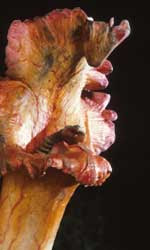THREADS (1984)
Former National History Museum employee Steve Drewett designed the BBC’s Triffids based on research into real life parasitic plants. Drewett invented the long, tubular sting for the creatures, explaining how the Triffids disabled and fed off their prey (something Wyndham’s source material is vague about).
CONTAINING one of the most effective title sequences – a mix of sickly green light, staring faces, eerie choral music and a disembodied tongue – the BBC’s adaptation of THE DAY OF THE TRIFFIDS is serious and unsentimental science fiction at its best, and the most effective realisation of John Wyndham’s work. The author’s 1951 magazine serial, Revolt of the Triffids, established the archetypal killer plant yarn, but also inspired the entire subgenera of the post-apocalyptic survival story as social comment. All the characters in this six-part television series are richly grounded but malleable, advancing the drama beyond a monster movie into a story of searches and reunions, amidst larger questions about individualism. Although the BBC publicised the show as Man versus Triffid, with the battling and bewildered Bill Masen (John Duttine) brandishing his Triffid Gun, the fibrously credible plants, with their plesiosaur-like necks and sado phallic "clackers", only have a limited role. After a retina-scorching light show of shooting stars, the post-disaster Britain is a kingdom of the blind, a land of stumbling living shells and hungry voices. This state of decay makes the Triffids an increasing threat, and an environment in which they can thrive. Most of the remaining sighted people look after their own interests, treating the blind like parasites, and excommunicating unproductive members. Yet, though this fascistic trait is unethical, it proves to be the best one.
The central theme of Wyndham’s major works is the struggle for survival in extreme situations; heroes are often ordinary people who try to sustain value when normality has collapsed. His stories may be considered trend setting in their insistence that planetary catastrophes would be extremely difficult for our delicate, self-assured and highly interconnected civilisation to deal with. Particularly adhering to these Wyndham values is the BBC’s multi-BAFTA winning THREADS, which dramatises a hypothetical nuclear war. Its domestic scenes, focusing on everyday life in 1980s Sheffield, and particularly the relationship between Jimmy (Reece Dinsdale) and Ruth (Karen Meagher), establish the interpersonal and socio-economic "threads" of society. Initially, media reports of the international tension are taken as background chatter, but the situation escalates to an apocalyptic attack. The cold exploration of events and the string of on-screen facts and figures are genuinely numbing, from the build-up to war and the immediate impact of the bomb, to the long-term consequences of a poisoned world. Portraying a sterile landscape of endless hunger and suffering, the final third is as dark as television drama has ever reached - the population is reduced to medieval numbers and the absolute basics of existence, with language mutating into a localised but limited collection of short, monosyllabic phrases. Chillingly, the flashpoint for the nuclear annihilation is Iran, the country American and British politicians are at this very moment issuing guarded warnings.
The central theme of Wyndham’s major works is the struggle for survival in extreme situations; heroes are often ordinary people who try to sustain value when normality has collapsed. His stories may be considered trend setting in their insistence that planetary catastrophes would be extremely difficult for our delicate, self-assured and highly interconnected civilisation to deal with. Particularly adhering to these Wyndham values is the BBC’s multi-BAFTA winning THREADS, which dramatises a hypothetical nuclear war. Its domestic scenes, focusing on everyday life in 1980s Sheffield, and particularly the relationship between Jimmy (Reece Dinsdale) and Ruth (Karen Meagher), establish the interpersonal and socio-economic "threads" of society. Initially, media reports of the international tension are taken as background chatter, but the situation escalates to an apocalyptic attack. The cold exploration of events and the string of on-screen facts and figures are genuinely numbing, from the build-up to war and the immediate impact of the bomb, to the long-term consequences of a poisoned world. Portraying a sterile landscape of endless hunger and suffering, the final third is as dark as television drama has ever reached - the population is reduced to medieval numbers and the absolute basics of existence, with language mutating into a localised but limited collection of short, monosyllabic phrases. Chillingly, the flashpoint for the nuclear annihilation is Iran, the country American and British politicians are at this very moment issuing guarded warnings.
A shell-shocked woman, staring directly to camera while cradling a teddy bear instead of her lost child, in the astonishing THREADS.
Barry Hines, one of the last great Northern working class writers, fashioned his script on evidence supplied by the British Medical Association and the Home Office, with literally dozens of experts from varying fields – including renowned astronomer and pioneering exobiologist Carl Sagan – consulted to guarantee sobering authenticity. Unsurprising then that THREADS convincingly depicts its horrors - despite budget restrictions - interspersing stock footage, photographs and model shots, with memorable imagery. Shooting the piece as if filming an actual disaster, producer/director Mick Jackson uses a documentary-maker’s dispassion that renders the gruesome scenes unbearably compelling; there is no music just ambient sound, and the acting is naturalistic from a cast of non-stars. The blend of personal tragedy and global catastrophe is deftly handled, but it is the attention to detail and the stunning breadth of the work which most impress.


